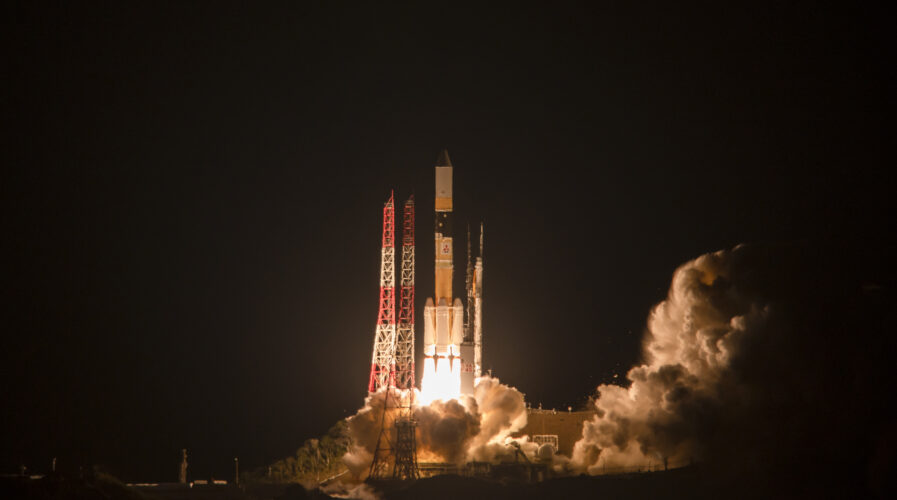
(Source – Inmarsat)
Inmarsat launches world’s most sophisticated commercial comms sat
- Inmarsat’s I-6 F1 is the first of seven new Inmarsat satellites to be launched by 2024 in fully-funded technology roadmap
- The satellite is the most sophisticated commercial communications satellite ever begins its journey to geostationary orbit
- I-6 F1 to deliver enhanced ELERA (L-band) and Global Xpress (Ka-band) for Indo-Pacific
When it comes to mobile satellite communication, Inmarsat tops the list. The British satellite company has now launched its first Inmarsat-6 satellite, I-6 F1, by Mitsubishi Heavy Industries (MHI) from the JAXA Tanegashima Space Center in Japan.
What makes the Inmarsat-6s (I-6) interesting is that it delivers an enhanced platform for those looking to embrace the next wave of world-changing technologies that ELERA enables, including the rapidly growing Industrial IoT satellite connectivity (IIOT) market segment, by providing dramatically increased network capacity and resilience.
According to Verified Market Research, the global satellite communication market size was valued at US$65.68 Billion in 2020 and is projected to reach US$131.68 Billion by 2028. Some companies are already building their own satellites with the hopes of providing better communication and connectivity for their services.
For Industrial IoT services like applications involving remote assets, regular reporting to headquarters is key. The new satellite enables everything from shipping containers to smart bulldozers to make regular reports back to their base of operational status.
Compared to previous satellites, this is the first-ever hybrid L- and Ka-band satellites, incorporating increased capacity and new technological advances for ELERA’s transformational L-band services alongside additional Global Xpress (GX) high-speed broadband capacity.
The new satellite adds to an existing global fleet of 14 geostationary satellites to extend Inmarsat’s commitment to mission-critical services while enabling a new generation of pioneering technologies to connect and sustain the world.
The launch is the first of seven planned for Inmarsat by 2024 in the company’s fully funded technology roadmap. The most sophisticated commercial communications satellite ever launched, I-6 F1 is comparable in size to a London double-decker bus, with a deployed solar arrays ‘wingspan’ similar to a Boeing 767 and a 9-meter-wide L-band reflector that will be deployed over the coming days.
The satellite will then be raised to geostationary orbit (GEO) approximately 36,000km above the Earth via its all-electric propulsion system and then undergo a thorough and extensive testing program. I-6 F1 will enter service in 2023. Ground stations in Western Australia will support I-6 F1.
Inmarsat: Perfecting data and IIOT
According to Rajeev Suri, CEO of Inmarsat, the launch marks Inmarsat’s newest technological leap forward as they maintain its strong commercial momentum and sector leadership. The satellite extends Inmarsat’s world-leading mobile satellite communications services for customers and partners, especially in the Indo-Pacific region.
The I-6 satellites demonstrate Inmarsat’s ongoing investment and commitment to its global leadership in L-band satellite services to 2040 and beyond for the benefit of mobility customers worldwide.
These new capabilities from the I-6s mean greater capacity and coverage, greater speeds, and a greater portfolio of innovative connectivity solutions for ELERA and Global Xpress (GX) networks. The I-6 satellites, like all Inmarsat ELERA and GX spacecraft, are backward-compatible with existing terminals, ensuring that current and future customers will continue to benefit from new advances.
The I-6s also substantially increase the effective capacity of the network available to ELERA customers with double the beams, 50% more spectrum per beam, and double the power of the I-4s, matching customer demand as and where it is needed. They also add further depth in Inmarsat’s global coverage for even greater assurance to customers of the redundancy and resilience of Inmarsat’s world-leading L-band network.
The GX6 payloads hosted on the I-6s add targeted high capacity to Inmarsat’s high-speed GX network, ensuring it continues to support the growing need of commercial and government customers for data, particularly in congested regions or hotspots where it is needed most.
The launch of the I-6s is further evidence of the momentum underpinning Inmarsat’s business and technology leadership in global mobility communications. I-6 plays an integral role in the reliable GEO infrastructure that underpins Inmarsat ORCHESTRA – the world’s first network that will combine GEO, highly elliptical orbit (HEO), low Earth orbit (LEO), and terrestrial 5G into one harmonious solution.
It is also important to note that Inmarsat is in the process of being acquired by the US Viasat company. The leader of home broadband delivery in the American market also provides WiFi on planes, a service that overlaps neatly with Inmarsat’s interests.
BBC reported that the British government has yet to give approval for a purchase that would see the country’s most significant space player transferred fully into foreign ownership. But whatever the outcome, Inmarsat will be pressing ahead with ambitious development plans.
READ MORE
- Safer Automation: How Sophic and Firmus Succeeded in Malaysia with MDEC’s Support
- Privilege granted, not gained: Intelligent authorization for enhanced infrastructure productivity
- Low-Code produces the Proof-of-Possibilities
- New Wearables Enable Staff to Work Faster and Safer
- Experts weigh in on Oracle’s departure from adland


